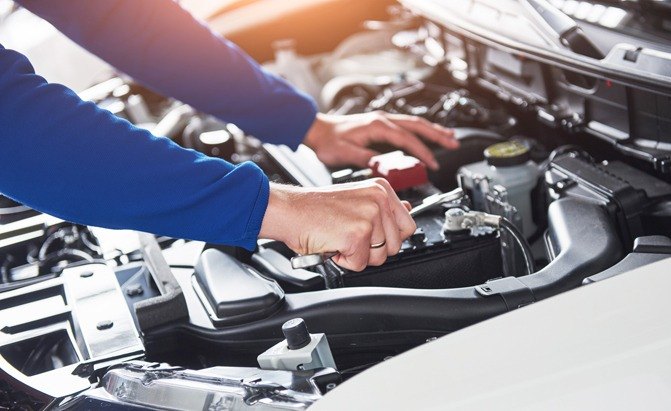Car Maintenance Schedule: When to Replace Car Parts

Cars are vehicles, vehicles are machines, and as machines, cars (and trucks, SUVs, vans, sedans, coupes, and most all other means of road-going conveyance) are all built of parts and components that will eventually wear out, wear down, and need replacement.
Further, many of the parts and components rely on a clean and fresh supply of fluid circulating within them to do their job properly. Like the parts themselves, fluids typically have a lifespan — after which point they need to be flushed out, refilled and replaced as part of your vehicle’s long-term care needs.
Below, we’ll look at a variety of the commonly replaceable parts and fluids that require occasional attention, how often you might change or replace them, and what might happen if you don’t.
But first, a caveat: the information below is a guideline only. Specific maintenance and replacement requirements vary widely from vehicle to vehicle, and the specific instructions you’ll need to follow for your specific year, make and model of car or truck are located in your owner’s manual.
We’ve listed the parts alphabetically, but if you want to jump to a specific part, use the table of contents to navigate.
Air Filter (Cabin)
Description: This filter is present on many modern vehicles, and cleans dust, pollen, allergens and other unwanted nastiness out of the air being into your cabin by the climate control system. This filter helps keep occupants more comfortable, helps prevents dust from building up in your car, and helps keep the inner workings of your heater and air conditioner clean, too.
How Often to Change / Replace: Cabin air filters are typically changed about once a year, or more often, if needed. Frequent use in a dusty climate or on dirt roads reduces the filter’s life. Changing a cabin air filter is typically easy and inexpensive.
What Happens if you Don’t: A clogged cabin air filter is a leading cause of poor performance from the vehicle’s heater, air conditioner, and defroster. Badly clogged filters can even damage your vehicle’s air conditioner components, and this damage won’t be covered by warranty.
PROTIP: If your heater or AC seems to be working poorly, or if you don’t remember when you last changed your cabin air filter, or if you didn’t know that cabin air filters were a thing that existed until reading this, then the cabin air filter in your vehicle probably needs to be changed, pronto.
Air Filter (Engine)
Description: Engines breathe in a constant stream of outside air at all moments while they’re running. This air passes through a filter that keeps unwanted contaminants from winding up inside of your engine. Like all filters, the engine air filter clogs up over time and needs to be replaced. This is typically an easy and inexpensive job.
How Often to Change / Replace: Roughly once per year, but this varies widely by vehicle. Some models have a built-in indicator that tells the driver when the filter needs changing. You’ll need to change it more often if you drive frequently on dirt roads, or in a dry, dusty climate.
What Happens if you Don’t: A clogged engine air filter can slowly suffocate your engine—causing it to burn more fuel, perform poorly, or even burn oil. Don’t underestimate how badly a clogged-up engine air filter can increase your engine’s fuel consumption.
PROTIP: Spring is a great time to change your air filter—given that it’s probably clogged up by insect and tree debris from the summer and fall, as well as dust, sand and salt particles from the wintertime.
Axle Fluid / Differential Fluid
Description:
Your vehicle’s engine and transmission aren’t its only components to require a fresh supply of a specific fluid circulating within to do its job properly. Many vehicles (especially those with rear or All-Wheel Drive) also require an occasional fluid change of its differential or axle fluid. Proper levels and condition of this fluid are vital to the prolonged and efficient life of this component, and the fluid cushions, lubricates and cools the gearset within this part of your driveline.How Often to Change / Replace: See your owner’s manual, as axle fluid fluid replacement intervals vary widely. Some vehicles never require a change of this fluid, others only require an axle fluid change after some period of hard use, while others require it on a more frequent basis. If you use your vehicle in severe conditions, for instance in an off-road setting or for frequent towing, you’ll want to change this fluid more often.
What Happens if you Don’t: Failing to change your axle fluid as per instructions in the owner’s manual can result in accelerated component wear, reduced parts life, and issues with performance and functionality from this component. Ensuring that any factory-set fluid changes relating to the axle or differential are adhered to is vital to the long life of this part, as well as maintenance of its warranty coverage.
PROTIP: If you drive frequently in an off-road setting, be sure to change your axle / differential fluid more frequently. Further, if your off-road adventures see you partaking in a deep water crossing, it’s a great idea to change the axle fluid as soon as possible afterwards. Crossing deep streams, for instance, can allow water to enter the axle, mix with its fluid, and cause potentially-serious problems. If in doubt, change it out!
Ball Joints
Description:
The ball joint is a small but important part of your vehicle’s suspension, and allows for precisely-controlled flexibility and travel between other elements of the suspension system. Like shocks and struts, ball joints have an impact on the way your vehicle steers, responds, and handles. These parts are generally maintenance-free and simply replaced when required.How Often to Change / Replace: Ball joints can last the life of the vehicle, or may need far more frequent replacing, depending on many factors. Like all suspension components, the ball joint’s lifespan is largely affected by the conditions in which the vehicle is driven. Frequent use on rough roads or harsh terrain can reduce the service life of the ball joints in your vehicle. In general, ball joints should be checked over as part of a regular suspension inspection, and replaced as needed.
What Happens if you Don’t: Driving a vehicle that’s in need of new ball joints is a bad idea, and may be dangerous. As these parts wear out, they’ll allow more play between the components they connect, allowing the factory-specified orientation of suspension components to go out of whack. Steering feel and handling response will suffer. Badly worn ball joints can seperate, which can cause instant and catastrophic suspension failure, the loss of a wheel, and a severe accident.
PROTIP: Like many suspension components, worn ball joints may give themselves away with unwanted noises, typically in the from of excessive popping, banging or smashing sounds from beneath the vehicle on rough surfaces. Don’t ignore these sounds—at their onset, make arrangements to have your vehicle’s suspension inspected professionally.
Battery
Description:
Your vehicle’s battery likely lives under the hood, under a rear seat, or buried beneath its trunk, and gets little second thought. Your battery is constantly drained by the on-board electronics in the vehicle, the engine starter, the lights, and various other systems. It’s also constantly recharged while you drive, by your vehicle’s alternator. The battery in your car is constantly charging and discharging—and like all batteries, its ability to do so eventually degrades to a point where the battery becomes weak and needs replacement.How Often to Change / Replace: A vehicle’s battery should last several years without any worry, and there’s often no pre-set interval relating to their replacement. After a few years of ownership, you’ll want to have your battery (and the associated charging system) inspected on a roughly-annual basis for signs of trouble. Once the battery shows signs of weakness or wear, it’s time to have it replaced.
What Happens if you Don’t: Running a vehicle with a weak battery is a recipe for headaches. Not only do you risk being unable to start your engine (especially in the cold), but problems are likely elsewhere as well. For instance, modern cars tend to exhibit random and frustrating problems across multiple electronic systems when the battery is unable to provide sufficient voltage. Spontaneous alarm system activation, non-functional controls, multiple random warning messages, wonky stereo head-units, and frequent malfunctions and false alarms from safety warning systems are just some examples.
PROTIP: To extend the life of your battery, and to fend off the likelihood of headaches, consider hooking a trickle charger up to your vehicle’s battery whenever it will be parked for more than a few days. This keeps the battery topped off and conditioned. Further, if buying a newer modern car, have the battery and charging system assessed professionally before you purchase. If the battery doesn’t pass the test with flying colors, replace it for reduced likelihood of annoying problems.
Brake Fluid
Description:
Brake fluid transforms the pressure applied to your vehicle’s brake pedal into hydraulic force that’s used to power your brakes and stop your car. The fluid is specially-formulated and often application-specific. Brake fluid spends it life in a sealed reservoir, brake lines, and the brake system components like brake calipers and brake drums.How Often to Change / Replace: In general, brake fluid is something you change a few times over the life of your vehicle, or on an as-needed basis. Vehicles engaged in severe use (for instance, towing or motorsports) typically need more frequent brake fluid changes. Check your owner’s manual for the scoop, and be sure to never stretch this important maintenance interval.
What Happens if you Don’t: Old and worn-out brake fluid can degrade, absorb moisture, allow corrosion to form within your brake system, and lead to a dramatic reduction in braking system performance.
PROTIP: You can’t over-change your brake fluid—so if you’re unsure whether or not this servicing is due (or whether or not you should do it) go ahead. Running fresh brake fluid helps your braking system perform better, and helps its other components last longer, too.
Brake Pads / Rotors
Description: Brake pads and rotors are friction-based components that work in sync to generate the force required to stop your car or truck. Every time you press the brake pedal, you wear these components out, slightly. Eventually, they wear out past a safe level, and need to be replaced.
How Often to Change / Replace: In general, pads and rotors are changed on an as-needed basis, and typically at the same time for best results. When regular maintenance and inspections of the braking system are carried out, changing brake pads and rotors may be required every few years. Numerous factors are at play, and your owner’s manual outlines some recommended service intervals, as well as some warning signs that you’re nearly due for some professional attention to your braking system.
What Happens if you Don’t: Ignoring the warning signs of brake wear, or failing to replace worn brake parts, will dramatically limit your vehicle’s ability to stop, and can lead to a serious accident.
PROTIP: An annual inspection and servicing of your brakes by a professional technician can go a long way towards increased safety and peace of mind, while ensuring your braking system components last as long as intended. Failure to maintain your braking system to factory guidelines will typically void warranty coverage on affected components.
Bushings
Description: Bushings are small isolators, typically made of rubber, that insulate parts of your vehicle’s suspension system and other components from one another. Bushings have an effect on ride quality, handling, steering feel, and more. They often resemble a rubber donut or tube and act like little cushions between various parts of the vehicle’s suspension components, as well as others. Bushings prevent metal-on-metal contact between various components.
How Often to Change / Replace: Bushings should generally last many years before requiring replacement. More frequent replacement may be required, depending on various factors, including the surfaces the vehicle is regularly driven on, or driving habits. In general, bushings should be checked over as part of an annual suspension inspection, and replaced as needed.
What Happens if you Don’t: Worn out bushings may negatively affect the vehicle’s alignment, cause excessive noise and harshness, and allow for excessive wear between the components they’re meant to isolate from one another. In extreme cases, continued driving on badly worn bushings can cause failure of other suspension components.
PROTIP: Sloppy handling and unwanted suspension noise are often signs of worn bushings within your vehicle’s suspension system. At the first sign of these symptoms, be sure to have the vehicle inspected professionally. Note that modern vehicles have many bushings in their suspension system, numbering into the dozens.
Coolant
Description: Engine coolant circulates through your vehicle’s engine at virtually all times while it’s running. The coolant travels through passageways in the engine where it whisks away heat built up within. The now-heated fluid travels to the heater core, where its heat is pumped into the cabin (if the heater is turned on) and then, travels to the radiator where the fluid is cooled down.
How Often to Change / Replace: This varies widely by vehicle. Some vehicles have lifetime coolant that never needs to be changed. Other vehicles need a coolant flush and refill every few years, or after a certain mileage limit.
What Happens if you Don’t: Worn out engine coolant can allow a buildup of harmful sludge within the system, cause wear or degraded performance from the cooling system, prevent proper heating of the vehicle’s cabin, and even cause corrosion to begin forming within the engine.
PROTIP: Coolant is another fluid that can’t be overchanged. If in doubt, flush it out! A coolant system flush and fill will help ensure your engine’s all-important cooling system is in tip-top shape, and can extend the life of associated components and systems, too.
Engine Oil/Filter
Description:
Oil and filter changes are the holy grail of vehicle longevity, and are of vital importance to ensuring that your vehicle’s engine performs, lasts and runs as intended for its lifetime. A fresh supply of engine oil is also vital to the health of other engine components, including the turbocharger (if equipped).How Often to Change / Replace: See your owner’s manual for the full scoop, and read carefully. Some vehicles need an oil change at a pre-set interval of so many miles or months, while others use an oil-life monitoring system that warns drivers when the vehicle is soon due for an oil change. Understanding the oil change intervals, or the oil life monitoring and advisory system in your vehicle is massively important when it comes to experiencing a long and trouble-free life from your engine.
What Happens if you Don’t: Skipping or stretching oil changes can cause a variety of problems, including poor fuel mileage, engine damage, poor performance, non-functionality of certain engine systems, rapidly-accelerated wear of the engine and turbocharger, and rapidly-accelerated buildup of harmful deposits within the engine. Skipping or stretching oil changes often voids any remaining warranty coverage on the vehicle powertrain, too.
PROTIP: Your owner’s manual explains when and how often to change the oil, and also, explains which type of engine oil and filter to use when completing this regular maintenance procedure. Especially in modern vehicles, it’s important to follow the instructions to the letter—changing the oil not a moment later than advised, and only using the factory-specified engine oil and filter combination at the viscosity recommended. Modern engines are built to exacting tolerances, and use of an improper grade of viscosity of oil can cause problems, or even result in engine damage in some cases.
Fuel Filter
Description: A fuel filter is used to prevent incidental contaminants from your fuel tank, gasoline, or fuel system from entering the engine where they can cause problems or damage. Over time, and for various reasons, dust, dirt, rust and other contaminants may find their way into your vehicle’s fuel system. Eventually, these can clog or restrict the fuel filter, which will need to be replaced.
How Often to Change / Replace: The fuel filter isn’t a frequently-replaced item, though it typically requires attention every few years. Older cars may require a fuel filter change every 20,000 to 50,000 miles, with newer cars approaching double that amount. The answer is in your owner’s manual. Severe use, or use in challenging environments may necessitate the need to change this filter more often. The fuel filter cannot be cleaned or serviced—it’s simply removed, discarded, and replaced.
What Happens if you Don’t: If you fail to change your fuel filter as recommended in your owner’s manual, expect reduced performance, poor fuel mileage, difficulty or failure to start the engine, random stalling, or a strong sensation that the engine is struggling to run or perform properly.
PROTIP: Note that the symptoms of a clogged fuel filter as listed above may have other causes, too. If in doubt about why your vehicle may be running poorly or exhibiting any of the symptoms above, seek the advise and assessment of a licensed technician, who will be able to quickly and effectively pinpoint the source of the trouble. Changing parts like a fuel filter in hopes of effecting a fix without confirming the cause is generally a waste of money.
Ignition Coil Packs
Description: Ignition coil packs are another vital ignition system component. In the coil packs, electricity supplied from the battery and alternator is ramped up to the current levels needed to fire the spark plugs, and that current is connected to the spark plugs via the spark plug wires. In general, ignition coil packs last the life of the vehicle—though failure is possible before that point since ignition coil packs live in a hot and harsh environment, given that they’re usually physically attached to the engine.
How Often to Change / Replace: In many cases, ignition coil packs are replaced on an as-needed basis in the case of poor performance or failure, and they’re not a standard maintenance item.
What Happens if you Don’t: A worn or malfunctioning ignition coil pack can cause poor performance, increased fuel consumption, difficulty starting or idling, and may contribute to ‘dirtier’ combustion within the engine, which can cause damage or problems to other internal components, as well as ignition system damage. Ignoring a malfunctioning ignition coil pack is a great way to waste fuel, suffer from poor performance, and even reduce the life of your vehicle’s engine.
PROTIP: If you notice a Check Engine Light (CEL) on a modern code that’s illuminated as a result of a MISFIRE code, a bad ignition coil pack is a not-uncommon culprit.
Oxygen Sensor (O2 Sensor)
Description: Modern vehicles utilize Oxygen Sensors to constantly scan and ‘read’ the contents of its exhaust stream. The information an O2 sensor gathers is fed back to the engine computer, and used to help fine-tune operation of the engine for optimal fuel efficiency and emissions.
How Often to Change / Replace: In general, shocks and struts are replaced on an as-needed basis, though they should be inspected on an annual basis by a trained technician. Signs of worn shocks and struts include a reduction in ride quality and comfort, unwanted slamming, banging or popping sounds when travelling over bumps in the road, and excessive bouncing and rebounding on uneven road surfaces. Most modern vehicles can go many years before requiring new shocks and struts.
What Happens if you Don’t: Continued driving of a vehicle with worn-out shocks and struts can pose a safety risk, as handling and control will be reduced. Expect reduced comfort by way of poor ride quality and added noise from the suspension on rough surfaces. Worn suspension components can also cause alignment problems, which can accelerate tire wear and increase fuel use.
PROTIP: An annual inspection of your vehicle’s complete suspension system is ideal for maximum peace of mind, control, and safety.
Spark Plugs
Description: Spark plugs are one of the most vital parts in your vehicle’s engine. With incredible precision, they create a tiny spark, many times per second, which is responsible for the ignition of the fuel and air mixture in your engine’s cylinders. This spark kicks off the controlled sequence of explosions that takes place within your engine, which is responsible for generating the power needed to drive your vehicle. Over time, spark plugs wear out and require replacement.
How Often to Change / Replace: This varies by vehicle, with many modern vehicles capable of 60,000 miles or more before requiring a replacement. High performance vehicles, or vehicles subjected to severe use, may require more frequent spark plug replacement. Intervals and other details are listed in the maintenance section of your owner’s manual. Spark plugs aren’t serviceable—they’re simply removed and replaced.
What Happens if you Don’t: Failing to change your spark plugs on time can result in sluggish or rough performance, a rough or sporadic idle, increased fuel use, and more. Do not underestimate the importance of on-time spark plug changes, especially in a modern engine.
PROTIP: Timely spark plug changes are vital to the long and efficient life of any engine, and even more important in the context of a Direct Injection (DI) engine. In this type of engine, skipping or stretching spark plug change intervals can result in a rapid accumulation of harmful soot and gunk, which can rapidly cause problems with other systems and components within the engine.
Spark Plug Wires (Plug Wires)
Description: The spark plug or plug wires connect your spark plugs to the vehicle’s ignition system, and deliver current to the spark plugs that’s used to generate their all-important spark. Plug wires may last the life of the vehicle, or may require occasional, infrequent replacement. Various conditions and factors affect the longevity of spark plug wires.
How Often to Change / Replace: In many cases, spark plug wires are built to last the life of the vehicle, but check your owner’s manual for the scoop. Otherwise, change the wires on an as-needed basis, perhaps every few years.
What Happens if you Don’t: A worn out or damaged spark plug wire (or wires) can cause problems with the ignition system. In some cases, the rubber insulation can crack or peel over time, allowing the wire to short-circuit or arc unintentionally to some nearby metal component under the vehicle’s hood. This can cause problems with performance, difficulty starting the engine, or even visible burn marks on the spark plug wires or nearby parts. If your engine is running poorly because of some problem with its ignition system, a check of the plugs and wires is a great place to start.
PROTIP: As a pre-emptive measure, some owners choose to replace their spark plug wires every 10 years or so, even if they don’t show visible signs of wear or damage.
Tires
Description: Your tires are arguably the most important part of your vehicle—since their condition and quality has a dramatic effect on the performance of your safety systems, how the vehicle steers, brakes, handles and responds, how well it’s AWD system works in inclement weather, and more. Tires have a direct relation to fuel efficiency, too.
How Often to Change / Replace: Change your tires on an as-needed basis. A quality set should last several years, but many factors affect the lifespan of any tire– including driving habits, overall vehicle maintenance, locale, and more. New tires should pose no concern for some time—though beyond a certain point, regular inspection of the remaining tire tread levels and overall condition are important to determine where the tires sit within their useful life.
What Happens if you Don’t: If you drive on worn-down tires, you’re a safety hazard to yourself, your occupants, and to the other motorists with whom you share the road. Once tires are worn past a certain point, they’re no longer able to grip, steer or stop as expected. They may also be at increased risk of failure, which can cause an accident. If in doubt, toss them out. Running poorly-maintained tires, or tires in poor condition, is a major safety concern, and a contributing cause of many motor vehicle accidents every year.
PROTIP: Regular inspections, pressure adjustments and rotations are key to ensuring a long life. Don’t underestimate the importance of maintaining proper tire inflation pressure, and adhering to the manufacturer-recommended rotation schedule, if you want to squeeze the most life out of your tires.
Transmission Fluid
Description:
Like your engine, your vehicle’s transmission relies on a clean and fresh supply of a specific fluid that’s circulated within it to keep all internal parts properly cooled, conditioned and lubricated. Transmission fluid in modern vehicles is often specially formulated for the specific transmission in question. When it’s time for a fluid change, you’ll want to be sure that your transmission is serviced by the dealer, and refilled only using the factory-specified fluid, for maximum peace of mind.How Often to Change / Replace: See your owner’s manual. Transmission fluid replacement intervals vary widely from vehicle to vehicle and transmission to transmission. Many modern transmissions never require a fluid change, perhaps unless used in severe conditions. Others require a transmission fluid change every few years. Manual transmissions may require occasional fluid changes as well. If in doubt, change your transmission fluid every two years, just to be safe.
What Happens if you Don’t: Failing to change your transmission fluid as per instructions in the owner’s manual can result in accelerated transmission wear, reduced transmission life, and issues with hard shifting, slippage, and more. Changing the transmission fluid as per the instructions in your owner’s manual is absolutely vital to the long and effective life of your vehicle’s transmission. Failing to properly service and maintain a transmission as per these instructions is a leading cause of problems and failure.
PROTIP: If your vehicle has a Continually Variable Transmission (CVT), use caution when servicing. This type of transmission typically has a very specific procedure to drain and refill, and requires a very specific type of fluid. Failing to follow the fluid replacement and refill instructions to a ‘T’ may cause transmission damage that won’t be covered by your warranty. A dealer is your best bet for CVT fluid servicing.
Power Steering Fluid
Description: In many vehicles, this specialized fluid circulates within the steering system, and is run through a pump which amplifies the effort exerted on the steering wheel by the driver for use in turning the vehicle’s wheels. Power steering fluid is often overlooked and given little second thought—largely because many vehicles rarely or ever call for a power steering fluid change.
How Often to Change / Replace: This varies widely by vehicle, and the answer on when and how often to change your power steering fluid is located in the owner’s manual. Expect to change the fluid infrequently (perhaps every 60,000 to 80,000 miles), if at all.
What Happens if you Don’t: When power steering fluid breaks down due to age and wear, it may allow excessive wear of other components within the steering system, including the power steering pump. Unwanted noises while steering, as well as an inconsistent or ‘rough’ steering feel are key signs of power steering problems, which may be caused by worn-down power steering fluid.
PROTIP: Note that some vehicles have no power steering fluid or power steering pump. If that’s the case with your vehicle, you won’t have to worry about occasional power steering fluid changes. Changing the power steering fluid in an older used car, if applicable, is a good pre-emptive measure to help fend off possible problems. If and when changing power steering fluid, be sure to have the work done by a licensed professional, and to only use the fluid specified in your owner’s manual.
Shocks and Struts
Description:
Shocks and struts are vital elements of your vehicle’s suspension system, and are part of a network of components that dictate how your vehicle handles, rides, steers and responds at all times. Shocks and struts are constantly being acted on by forces from the road beneath, and many factors contribute to how long they last before requiring replacement. Plug wires may last the life of the vehicle, or may require occasional, infrequent replacement. Various conditions and factors affect the longevity of spark plug wires.How Often to Change / Replace: In many cases, spark plug wires are built to last the life of the vehicle, but check your owner’s manual for the scoop. Otherwise, change the wires on an as-needed basis, perhaps every few years.
What Happens if you Don’t: A worn out or damaged spark plug wire (or wires) can cause problems with the ignition system. In some cases, the rubber insulation can crack or peel over time, allowing the wire to short-circuit or arc unintentionally to some nearby metal component under the vehicle’s hood. This can cause problems with performance, difficulty starting the engine, or even visible burn marks on the spark plug wires or nearby parts. If your engine is running poorly because of some problem with its ignition system, a check of the plugs and wires is a great place to start.
PROTIP: As a pre-emptive measure, some owners choose to replace their spark plug wires every 10 years or so, even if they don’t show visible signs of wear or damage.
We are committed to finding, researching, and recommending the best products. We earn commissions from purchases you make using the retail links in our product reviews. Learn more about how this works.
Photo credit: Standret / Shutterstock.com

Justin Pritchard, an award-winning automotive journalist based in Sudbury, Ontario, is known for his comprehensive automotive reviews and discoveries. As a presenter, photographer, videographer, and technical writer, Justin shares his insights weekly through various Canadian television programs, print, and online publications. In 2023, Justin celebrated a significant milestone, airing the 600th episode of his TV program, AutoPilot. Currently, he contributes to autoTRADER.ca, Sharp Magazine, and MoneySense Magazine. His work as a technical writer, videographer, presenter, and producer has been recognized with numerous awards, including the 2019 AJAC Video Journalism Award and the 2018 AJAC Journalist of the Year. Justin holds a Bachelor of Commerce (Hons) from Laurentian University, which he earned in 2005. His career in automotive journalism began that same year at Auto123.com. Since then, he has written one of the largest collections of used car buyer guides on the internet. His passion for photography, nurtured from a young age, is evident in his work, capturing the scenic beauty of Northern Ontario. Living in a region with a particularly harsh winter climate has made Justin an expert on winter driving, winter tires, and extreme-weather safety. Justin’s significant achievements include: 2019 AJAC Video Journalism Award (Winner) 2019 AJAC Road Safety Journalism Award (Runner-Up) 2019 AJAC Automotive Writing (vehicle review topics) (Winner) 2019 AJAC Automotive Writing (technical topics) (Winner) 2018 AJAC Journalist of the Year You can follow Justin’s work on Instagram @mr2pritch and YouTube @JustinPritchard.
More by Justin Pritchard



















































Comments
Join the conversation